
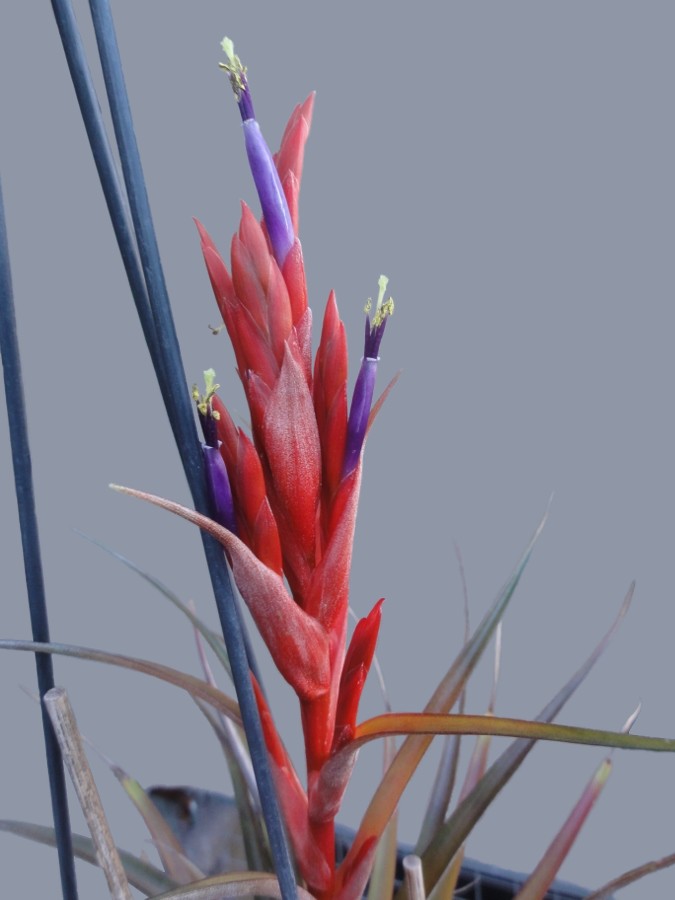
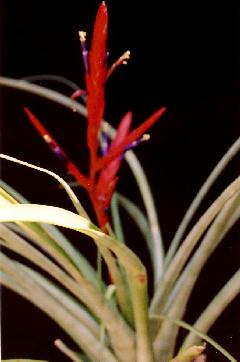
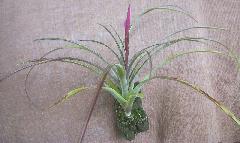
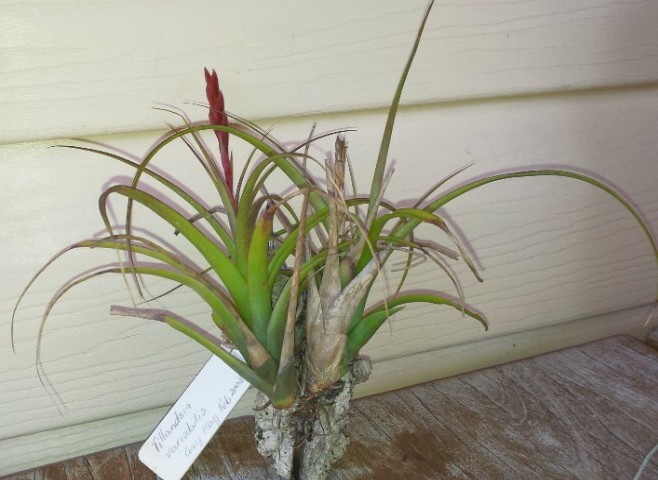
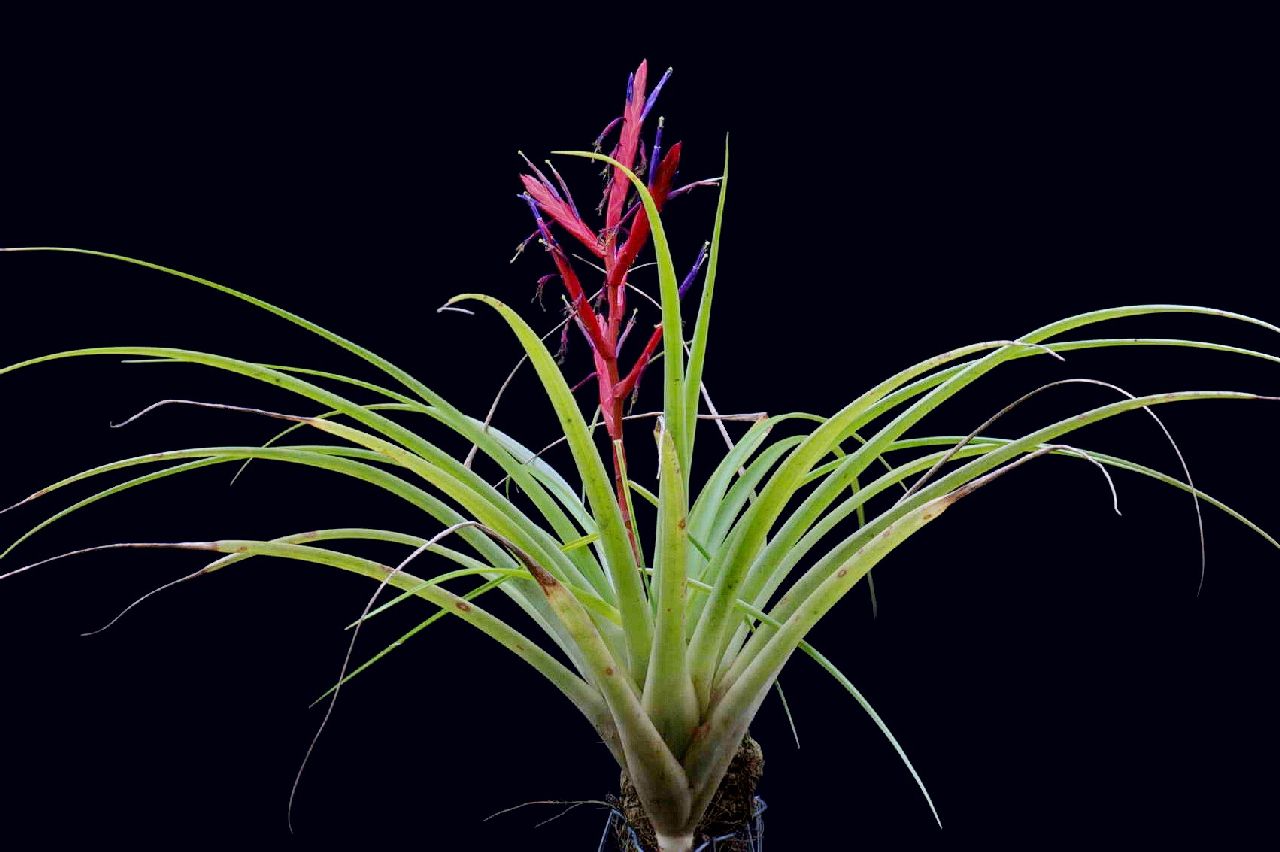
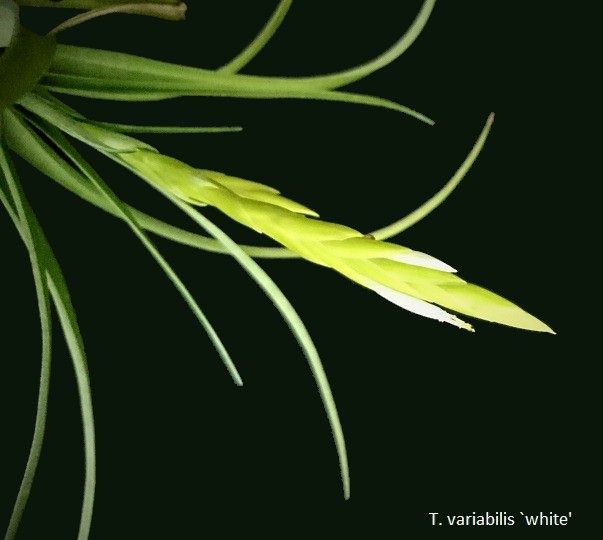
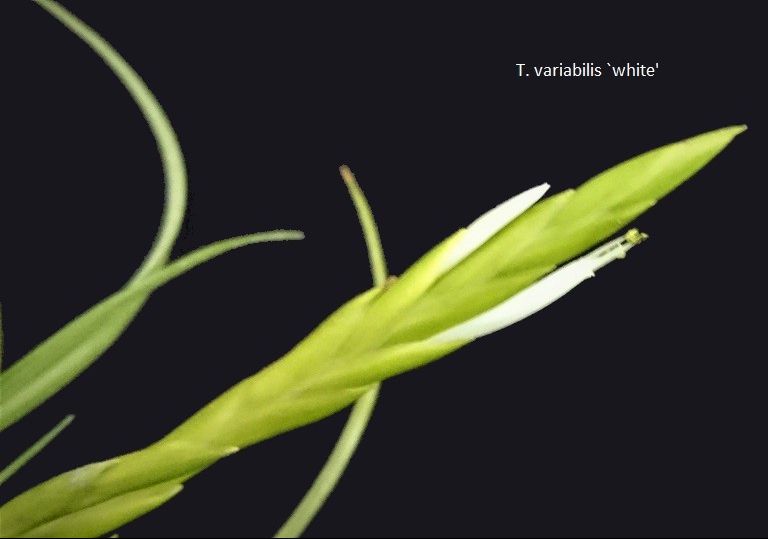
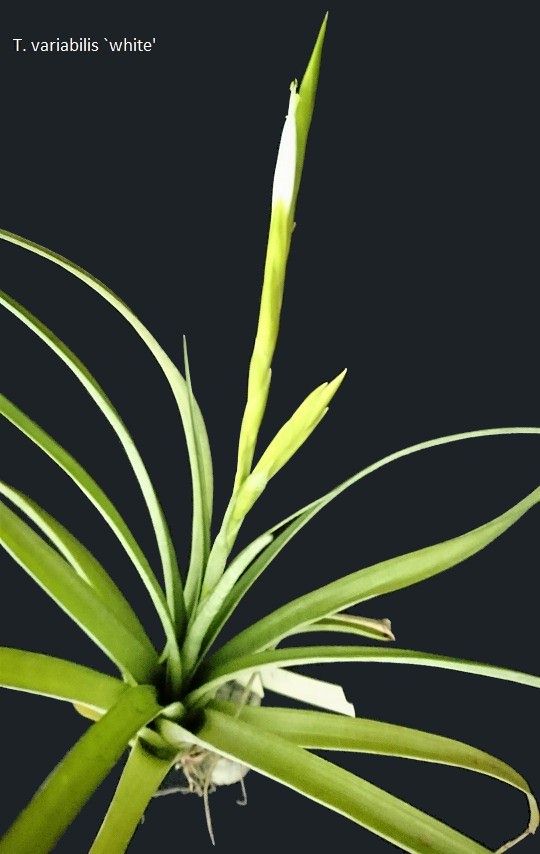
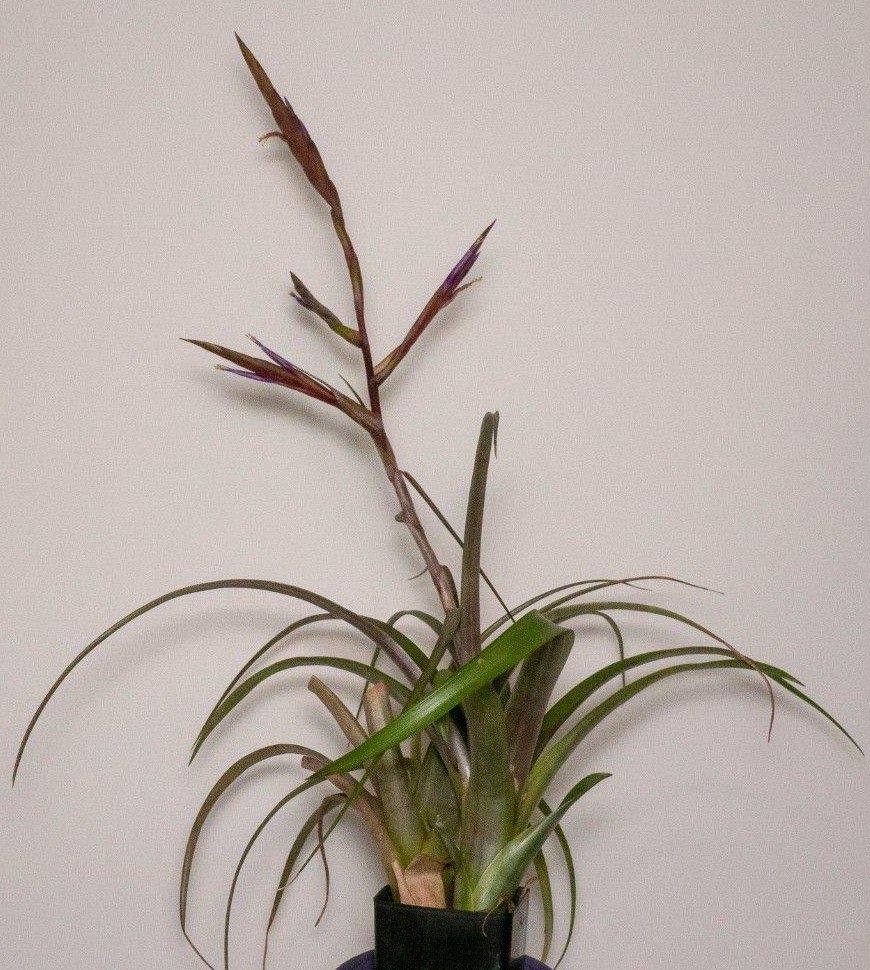
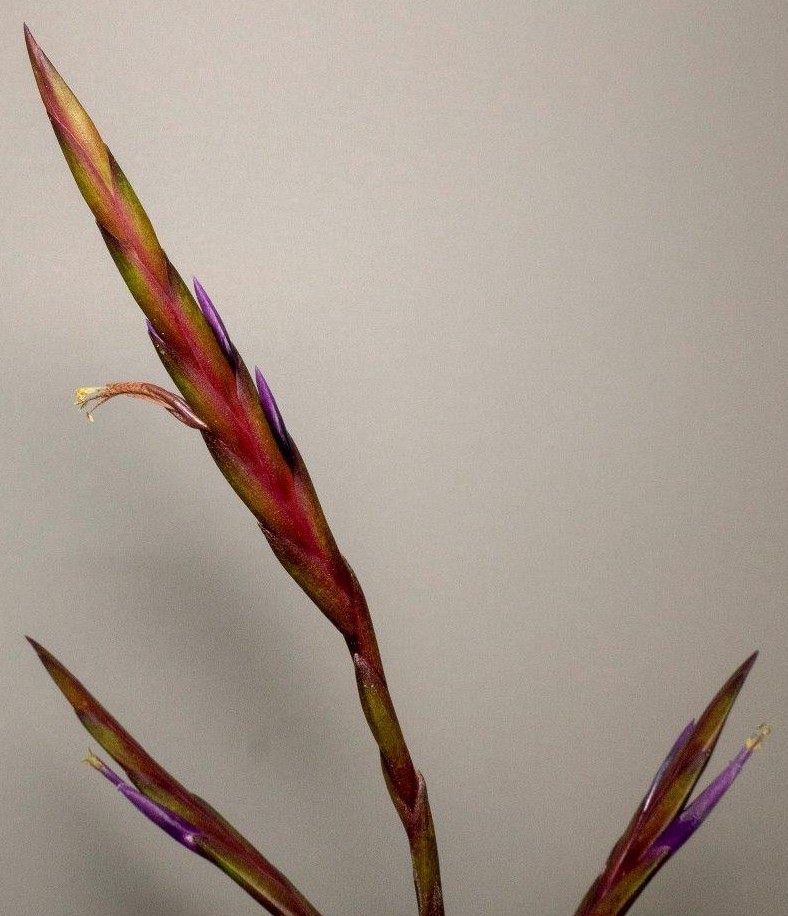
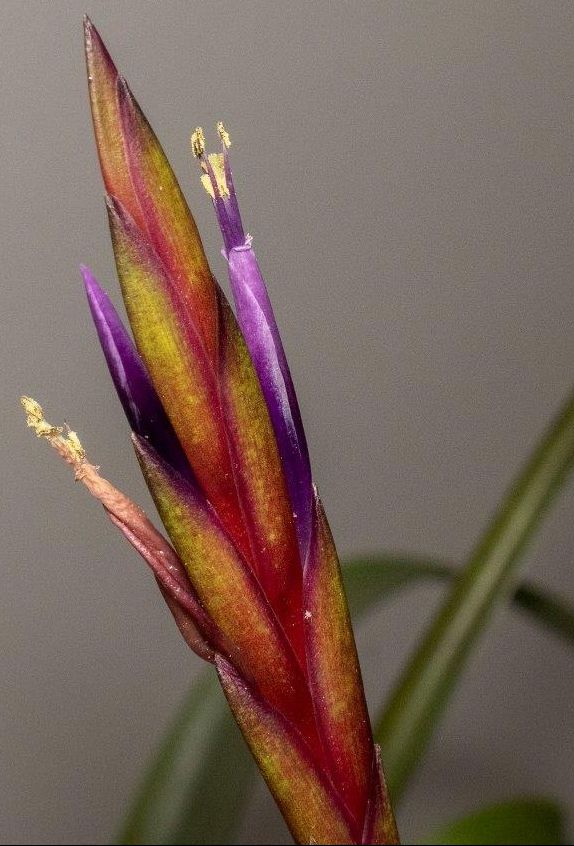
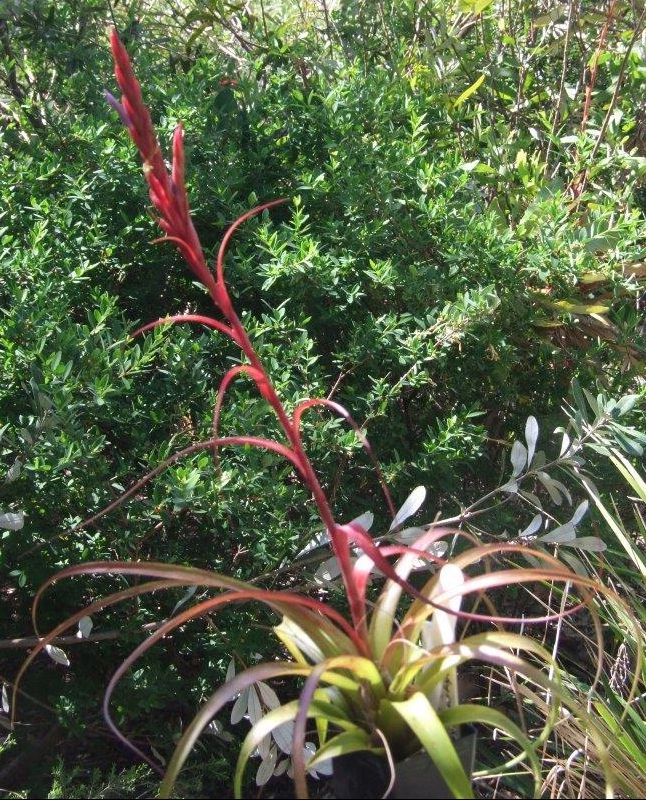
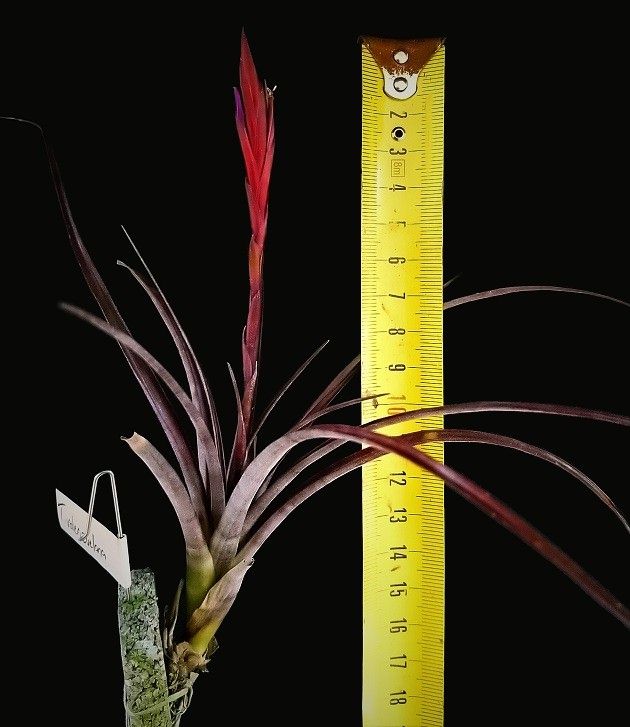

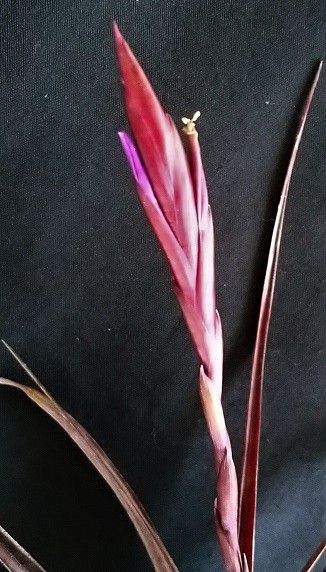
Tillandsia domingensis Mez in Fedde, Rep. XVI. (1919)73. treated by S&D as a synonym of T. valenzuelana
Plant flowering to 0.3m high
Leaves many, forming an obconical utriculate shape, to 0.2m long, to 25mm wide above the sheath, then gradually narrowing to a very acute tip, leathery, when dry almost flat, above sub-glabrous, underneath appressed grey lepidote so that it seems more or less becoming violet at the base.
Scape enclosed by bracts, short, moderately strong, now erect, now nodding
Scape bracts sheath very thick (sometimes excepting the uppermost one) with elongated subulate blade, almost inflated, erect, exceeding the internodes
Inflorescence almost few or almost many flowered, mostly simple, moderately lax but sometimes almost pinnate with at best, 3 distichous spikes, the middle one larger, the lateral ones a little smaller, recurved to erect, laxly arranged. If simple to 12cm long, 13mm wide, well complanate, linear, acute tip, to 12 flowered.
Primary bracts (when inflorescence compound) all the same as the scape sheaths, much shorter than the side spikes
Floral bracts totally lax, barely imbricate, almost erect to erect, leathery, strongly concave, not notably keeled, tip not at all incurved, the back(outside) strongly vein lined, appressed lepidote, to 27mm long, much exceeding the sepal.
Flowers erect to 40mm long
Sepals almost equally free, to12mm long, leathery, glabrous, blunt keeled, by no means veined, moderately wide lanceolate, acute.
Petals main part and tip a continuous erect tube, violet, shorter than the porrect stamens
Habitat Hispaniola, Sto. Domingo, Constanza, 1400m. (Turkheim n. 3230)
From McVaugh in Flora Novo Galiciana 1989
Tillandsia valenzuelana A. Rich. in Sagra, Hist. Cuba. 11 {Fl. Cub. 3}: 267. 1850.
On rocks or trees, sometimes on limestone, from near sea-level to 2200 m, in Nueva Galicia 1200-1500 m in the mountains of the Pacific slope, flowering ?May, fruiting Nov.
W Mich., Pue., Ver., S.L.P., Q.R., Chis.; Centr. Amer.; s Fla.; W. Ind. (Cuba, Vuelta de Abajo, J. M. Valenzuela, the type {Sagra, P, the holotype. according to Smith}); S. Amer. Little known in western Mexico.
Limestone rocks W of Aguililla and 15-16 km SE of Aserradero Dos Aguas {McVaugh 24743, det. Smith (1971), confirmed J. Utley, 1984}; Coalcoman {Rzedowski 16675, ENCB, cited by Smith (in Smith & Downs, 1977), not seen}.
Plant acaulescent, 20-60 cm high at flowering time;
leaves soft, numerous, often l5-20 in a rosette, up to ca 40 cm long (the outer ones commonly bladeless), very densely pale-appressed-lepidote, the green of the abaxial surface masked by the grayish scales, the adaxial surface sometimes nearly glabrous;
sheaths large, ovate, often 3 cm wide, concolorous with and merging with the blades;
blades linear-triangular, attenuate, flat or involute in drying, 1-2.5 cm wide near base:
scape erect or ascending, slender (2-3 mm thick), its bracts erect, imbricated, densely lepidote, pink or red, at least the lower ones with linear blades;
inflorescence simple, or pinnately compound with a few spikes, the simple inflorescence or terminal (usually largest) spike with sterile bracts at base, 5-20 cm long, 1-2 cm wide, distichously 6-17-flowered;
primary bracts like the upper-scape bracts, their sheaths shorter than the axillary spikes;
floral bracts erect or at length divergent, usually exposing the angled and slightly flexuous rachis, 1.8-3.2 cm long, 2-3 times as long as the internodes, elliptic-oblong, convex on the backs but not (or rarely) keeled, evidently longer than the sepals, thin, prominently nerved, subglabrous, pink or red;
flowers subsessile;
sepals oblong, obtuse, ca 1.2-2.8 cm long, glabrous, the adaxial pair somewhat connate;
petals linear, acute, 3 cm long, lilac or violet-purple;
stamens exserted;
fruit fusiform, 2-3.5 cm long.
This species is superficially somewhat like Tillandsia polystachia and may be confused with that species. Smith (in Smith & Downs, 1977) reported that T. polystachia occurs at elevations up to 1800 m, but in Nueva Galicia it appears to be primarily a lowland species, well known on the coast of Jalisco and ascending into the foothills but probably not to more than 1000 m. C. S. Gardner, collecting in the lowlands of Jalisco between Tomatlan and Barra de Navidad, found what she took to be T. polystachia (no. 1358.5) and T. valenzuelana (no. 1358.1) at the same locality. Aside from this, the two localities in Nueva Galicia from which T. valenzuelana has been reported are both inland at somewhat higher elevations.
Detail from Baker 1889
46. T. BRACHYPODA Baker in Journ. Bot. 1887, 237.
Leaves many in a dense rosette; dilated base ovate, an inch broad;
blade lanceolate-setaceous, rigidly coriaceous, ½ ft. long, ½ in. broad low down, tapering gradually to the point, densely finely lepidote.
Peduncle 2-3 in. long;
bract-leaves crowded, with short free points.
Inflorescence a dense simple distichous spike 3-4 in. long, ½ in. broad;
flower-bracts oblong-lanceolate, naked, ¾ in. long.
Calyx reaching nearly to the tip of the bract.
Petal-blade oblong.
Stamens longer than the petals.
Hab. Mountains of Venezuela, Fendler 1527 !
126. T. SUBLAXA Baker in Journ. Bot. 1887, 280.
Leaves few in a rosette, ensiform-setaceous from an ovate base an inch broad, 6-9 in. long, ½ in. broad low down, rigidly coriaceous, thinly lepidote.
Peduncle as long as the leaves;
bract-leaves with long free points.
Inflorescence a moderately dense simple spike 4-5 in. long, ¾ in. diam;
flowers 6-8 on a side, very ascending;
rachis flexuose;
flower-bracts oblong-lanceolate, ¾-? in. long.
Calyx ½ in. long;
sepals oblong, obtuse.
Petal-blades lilac, convolute in a cylindrical tube ½ in. long.
Capsule an inch long.
Hab. Jamaica, Purdie ! Porto Rico, Sintenis 6885 ! St. Domingo, Eggers 1569 ! 2618 ! Habit of T. polystachya, from which it differs by its simple sublax spike. I cannot, from the brief description, separate the Mexican T. variabilis Schlect. in Linnaea xviii. 418.
Tillandsia variabilis SCHLECHTENDAL Linnaea 18 : 418 (“1844”, 1845). by W Weber in Feddes Repert. 95:597-8. 1984
HAL 45636, Bogen l, Lectotypus: Eine bluhende Pflanze.
Pflanze bluhend 30cm hoch mit fragmentarischer Infloreszenz wenig kurzcr als die Blatter. Blatter zahlreich, aufrecht bis ausseinandergespreizt, rosettenformig angeordnet, dicht angedruckt fein beschuppt. Blattscheiden nur unauffallig von den Spreiten abgesetzt, bis 45 mm lang, 20 mm breit, gleichfarben mit den Spreiten. Blattspreiten schmal dreieckig, lang zugespitzt, bis 25 cm lang. Infloreszenz-schaft aufrecht, 15 cm lang. Schaftbracteen imbricat den Schaft umhullend, etwas langer als die Intcrnodien, mit lang fadenformig zugespitzten Spreiten. Infloreszenz zusammengesetzt aus fragmentarischer terminaler Ahre und einer 5-blutigen seitlichen Ahre. Primarbraktee gleich den Schaftbracteen. Ahren ziemlich dicht zweizeilig. Blutenbrakteen spitz-lanzettlich, ungekielt, oder undeutlich zur Spitze gekielt, genervt, angedruckt beschuppt. 19-21 mm lang, die Sepalen uberragend. Sepalen frei, lanzettlich, gekielt, fast unbeschuppt, 15 mm lang. Kapseln 25 mm lang.
Sammleretikett (scripsit Schiede): Tillandsia sp. pr. Papantla in arboribus Jan. 29;
Etikett (scripsit Schlechtendal) : 1003 Tillandsia aurea Presl, Rel. Haenk. p. 124 t. 24 ? Specimen unicum florens.
Bogen 2: Isolectotypus: Eine 24cm hohe Pflanze mit verarmter einfacher Infloreszenz. Sammleretikett (scripsit Schiede): Tillandsia sp. in arboribus Papantlae Jan. 29.; handschriftlicher Bestimmungszettel: Tillandsia valenzuelana A. Rich. Carl Mez.
HAL 45634 (2 Bogen): Zwei bluhend 40 cm hohe Pflanzen mit aus 4 bzw. 6 Ahren.
zusammengesetzter Infloreszenz. Sammleretikett (scripsit Schiede) : Tillandsia spec.
In arboribus Malpays de Naulingo reg. temperatae calidioris April 29, cal. internus pallide violaceus; handschriftlicher Bestimmungszeftel: Till. valenzuelana A. Rich. Carl Mez. Duplikate in anderen Herbarien sind nicht bekannt. Obwohl Carl Mez die Typen der Till. variabilis Schldl. 1845 in den Handen hatte, erkannte er sie nicht als solche, sondern bestimmte sie als die spater beschriebene Till. valenzuelana A. Rich. 1850. In beiden Monographien von Mez (1896; 1935) und auch der von L. B. Smith (1977) wird Tillandsia variabilis Schldl. 1845 in der Liste der dubiosen Arteu gefuhrt. Aus Prioritatsgrunden wird die Revalidisierung wie folgt erforderlich: Tillandsia variabilis Schlechtendal, Linnaea 18: 414 (“1844”, 1845).
Syn.: Till. valenzuelana A.Richard 1850. - Till. moritziana Beer 1857; Platystachys moritziana Beer 1857. - Till. laxa Grisebach 1864. - Till. kunthiana sensu Grisebach 1865, non Gaudichaud 1842. - Till. brachypoda Baker 1887. – Till. sublaxa Baker 1887. - Till. polystachya L. var. alba Wittmack 1889. – Till. houzeavii Chapman 1893. - Till. purpusii Mez 1916 p. p. - Till. domingensis Mez 1919.
Lectotypus: Schiede s. n. Januar 1829, Mexico; Veracruz, Papantla (HAL 45636. 1)
vide Smith & Read, Phytologia 52, 55 (1982).